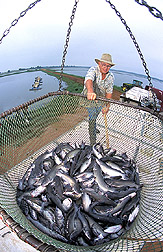New, Convenient Catfish Products Created
In the mood for something different to eat?
Jin Kim, a food technologist formerly with the Agricultural Research Service's Aquaculture Systems Research Unit, which is located at the University of Arkansas at Pine Bluff (UAPB), has developed several new food products from mis-cut fillets and nuggets, low-value byproducts of the catfish fillet processing industry.
Nuggets are small pieces of belly flap meat—abdominal muscles that processors trim off fillets. Developing value-added products from these fish portions will increase product utilization and profitability of processing. The U.S. catfish industry needs new markets to offset competition from imported fish products, especially those similar to catfish in quality and taste.
Kim’s research focused on developing these kinds of products, making sure their texture, taste, and quality are appealing to consumers.
Convenient, ready-to-eat, microwaveable catfish wonton turnovers are one new creation from Kim. He’s also stuffed pasta with marinated and grilled nuggets that are seasoned with Italian-style and Oriental spices. Kim’s latest creation is made from catfish trimmings compressed into a patty with a hamburger press.
Industry has already shown interest, and the research unit recently received a grant from the Arkansas Catfish Promotion Board for the projects.
The channel catfish market has grown by more than 40 percent since 1995, according to USDA statistics. But one drawback for catfish nuggets is the price per pound they bring at market, which is nearly half the price fillets bring.
Why the low price? Kim says the belly flap’s peritoneal membrane makes the appearance of the nugget meat less desirable to consumers. He has found that including ingredients such as cooked spinach or wrapping the nugget in pasta make it unnecessary to remove the membrane, which is unpractical.
“During taste panel studies, participants did not call attention to the membrane’s appearance,” Kim says. “In addition to nuggets, other meat portions that are hard to market simply because their appearance is not uniform, such as mis-cut fillets, can be used in these new products.”
Kim has also developed methods for improving taste and texture of the nuggets by rinsing the meat with water and incorporating various ingredients and seasonings.
For instance, compared to the 7- to 10-percent fat content of fillets, belly flap meat has a fat content of almost 15 percent, which can limit its shelf life and contribute to undesirable sensory qualities. But Kim’s special ingredients and preparation methods reduced that fat content, and taste panelists did not find the finished products to taste “fatty” or “fishy.”
A market study in Little Rock by Kim and UAPB aquaculture marketing professor Kwamena Quagrainie showed that people are prepared to purchase the finished wonton product Kim developed.—By Jim Core, Agricultural Research Service Information Staff.
This research is part of Aquaculture, an ARS National Program (#106) described on the World Wide Web at www.nps.ars.usda.gov.
For more information about this research, contact Jim Core, USDA-ARS Information Staff, 5601 Sunnyside Ave., Beltsville, MD 20705; (301) 504-1619, fax (301) 504-1486.
"New, Convenient Catfish Products Created" was published in the January 2006 issue of Agricultural Research magazine.







